Overview
 Engaging Faith-based Communities in Citizen Science through Zooniverse (Engaging) was an initiative designed to broaden participation in citizen science (aka “people-powered research” or community science1) among religious and interfaith communities by helping them to engage with science using the online Zooniverse platform. Citizen science is a powerful way to build positive, long-term relationships across diverse communities by “putting a human face” on science and scientists, since participating in real scientific research is a great way to learn about the process of science as well as the scientists who conduct research. The Engaging initiative provided models for how creative partnerships can be formed between scientific and religious communities that empower more people to become collaborators in the quest for knowledge. Despite the difficulties imposed by the pandemic, I’m encouraged by what this project achieved, and the possibilities for expanding its impact in the future!
Engaging Faith-based Communities in Citizen Science through Zooniverse (Engaging) was an initiative designed to broaden participation in citizen science (aka “people-powered research” or community science1) among religious and interfaith communities by helping them to engage with science using the online Zooniverse platform. Citizen science is a powerful way to build positive, long-term relationships across diverse communities by “putting a human face” on science and scientists, since participating in real scientific research is a great way to learn about the process of science as well as the scientists who conduct research. The Engaging initiative provided models for how creative partnerships can be formed between scientific and religious communities that empower more people to become collaborators in the quest for knowledge. Despite the difficulties imposed by the pandemic, I’m encouraged by what this project achieved, and the possibilities for expanding its impact in the future!
Introduction
Wonder and awe lie at the heart of both scientific investigation and thoughtful religious reflection. As an astronomer who studies the origins of stars and as a person of faith, I’ve participated in the science and religion dialogue for decades, because I believe that building bridges and creating venues for two-way communication are essential to counteracting “culture wars” that present science and religion as enemies, to the detriment of both. Perceptions of science as hostile to religion have led many people to reject scientific claims, and local governments to adopt educational policies that are not in the best interest of communities. Furthermore, these perceptions adversely affect the participation in science by people of faith, and disproportionately exclude minorities and women (e.g., Bolger & Ecklund 2020; Barnes & Brownell 2018; Ecklund et al. 2019). Diversifying science requires respectfully and constructively engaging with different worldviews and cultures.
Sadly, the news is replete with stories of culture clashes and destructive polarization across society; perhaps nowhere is this more evident than in the so-called “war” between religion and science. Of course, this warfare model conveniently neglects the fact that there are many people of faith who have positive views of science, and throughout history, there have been many scientists who are members of religious communities, including scientists who are themselves ordained in various faith traditions. Throughout the pandemic, many faith communities have modeled exemplary behavior in following the best available scientific guidelines, sharing well-vetted information and resources, and otherwise prioritizing the safety and health of themselves and the public. For example, Christianity Today published Martin Luther’s sage advice on how Christians should behave during a plague, and religious leaders such as Pope Francis, and Christian organizations, such as the National Association of Evangelicals, have strongly urged followers to get vaccinated. Furthermore, an increasing number of interfaith communities have sprung up around common values. A shared commitment to social and environmental justice lies at the heart of organizations like Interfaith Power and Light that advocate for addressing urgent challenges to life as we know it on Earth, such as climate change and environmental degradation.
How can we facilitate more kinds of experiences that bring people together, rather than drive them apart? Several years ago, physicist and Lutheran pastor George Murphy drew my attention to a quote by Goethe that I think points us in the right direction. The English translation of the quote is, “Who wishes to understand the poet must go to the poet’s land.” The meaning is clear; we gain appreciative knowledge of others by stepping into their communities to get an “insider’s view” of what they are like. Many faith communities put this principle into practice by inviting “outsiders” into their communities to participate in events and services at their places of worship, so others can come to know them better. In a similar fashion, citizen science enables everyone to “walk into the scientists’ land” by participating in research with scientists, and possibly even making new discoveries!
Public Participation in Research and Zooniverse
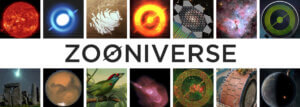
Credit: Becky Rother, Zooniverse
Citizen science seeks to offer everyone, regardless of their age, background, or prior experience, an opportunity to take part in the acquisition of new knowledge, while contributing to research that would be impossible or impractical to conduct without the efforts of many people. Public participation in scientific research enables people to see science as a process rather than a collection of facts, as they become active explorers and learners, rather than passive receivers of knowledge. Zooniverse is the world’s largest and most popular online platform for people-powered research, where more than two million people — people of all ages and from all walks of life — contribute to a wide selection of projects in the sciences and humanities that are led by investigators at over 120 research institutions around the world.
Once a person creates a Zooniverse account, they can start participating in a project within minutes. It’s entirely up to participating volunteers to decide how long they want to spend on a project and how deeply they want to become involved. Some people only spend minutes working on a project, while others participate over weeks or longer. Each project has its own tutorial that shows you how to participate. Depending upon the type of research project, you’ll be asked to help identify (or “classify”) or measure things in different kinds of “subjects.” Subjects can be images, photographs, texts, graphs, videos, or even sound recordings. A number of people examine each individual subject, and human beings are great at these tasks, so there’s no need to stress about making a mistake! Each project combines contributions from many individual volunteers, relying on a version of the ‘wisdom of crowds’ to produce reliable and accurate data.2
Through “Talk” discussion boards, the Zooniverse platform provides opportunities for volunteers to interact with the researchers leading projects. In fact, many of the most interesting discoveries from Zooniverse projects have come from discussion between volunteers and researchers. Interactions with scientists can also help build confidence in individuals who doubt their own abilities to contribute to research in meaningful ways. The platform also provides many resources for teachers at all educational levels who wish to use Zooniverse in different learning settings. It even provides a tool that can be used by anyone interested in building their own crowd-sourced research project. Projects that are launched on the main Zooniverse website are available to people around the world, and must undergo several reviews by Zooniverse leadership; however, the project-builder tool can also be used to build small-scale projects of interest to specific communities.
The Engaging initiative was advertised through multiple venues and organizations. Throughout the project and beyond, I’ve had the pleasure of interacting with numerous individuals representing seminaries, communities of faith, interfaith organizations, and organizations dedicated to constructive dialog between science and religion, to discuss collaborative ways of using Zooniverse in various formal and informal settings in order to enhance public understanding and appreciation of science. The Engaging website, maintained by the American Association for the Advancement of Science (AAAS) Dialogue on Science, Ethics, and Religion (DoSER) program, contains links to recorded presentations, tutorials, workshops, blogs, and articles on the project. We intend to expand these links as we reach new audiences, strengthen collaborations, and encourage continuing engagement.
A Stellar Advisory Board
From the start, the Engaging initiative benefitted from having a multi-talented and diverse Advisory Board that helped advertise the initiative through their respective venues and among their communities. Our six Advisory Board members include representatives from the Abrahamic faith traditions, scientists, people experienced in interfaith leadership, and people experienced in science and religion dialog. Brother/Dr. Guy Consolmagno (Director of the Vatican Observatory) helped promote Zooniverse in Catholic schools and through Vatican Observatory social media; Ms. Susan Abrams (CEO of the Illinois Holocaust Museum and Education Center) and her associate, Vice President of Education and Exhibitions Ms. Kelley Szany, advertised Zooniverse through educator e-blasts reaching more than 30,000 individuals; Dr. Michael Zimmerman (Founder and Executive Director of the Clergy Letter Project: CLP) included information on Zooniverse in the CLP monthly e-newsletter and set up a web page with links to information about the Engaging initiative; Dr. Gayle Woloschak (Professor of Radiation Oncology & Radiology and Associate Dean for Graduate Student & Postdoctoral Affairs at the Feinberg School of Medicine, Northwestern University; Adjunct Professor of Religion & Science at the Lutheran School of Theology in Chicago) suggested potential new projects for the Zooniverse platform; Ms. Susan Barreto (Editor, Covalence Magazine hosted by the Lutheran Alliance for Faith, Science and Technology) wrote several articles about the Engaging initiative for Covalence, an archived e-newsletter that attracts 2,000-3,000 unique users each month; and Ms. Teri Simon (Director of Executive Office, representing Dr. Eboo Patel, Founder and President of the Interfaith Youth Core) helped promote Zooniverse at the November 2019 meeting of the American Academy of Religion.
Zooniverse in Seminaries
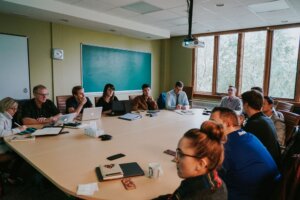
Students at Providence Theological Seminary | Credit: Robert Dean, PTS
Recognizing that many people look to their religious leaders for guidance on issues relating to science and technology, even though clergy members may have had little exposure to science, DoSER’s Science for Seminaries program has been helping diverse seminaries integrate science into their core curricula since the program was launched in 2013.3 One great way to do this is to give seminarians experiences with real science. Research projects on Zooniverse include many scientific topics that may be of particular interest in theological education. For example, cosmology, biological evolution, anthropology, the environment, and medicine intersect with theological concerns in the areas of Creation, Creation care, theological anthropology, health care, and social justice. Seminary students can work on selected Zooniverse projects individually or in teams, chronicling their experiences and reflecting on how the science relates to theological issues.
As an advisor for DoSER’s Science for Seminaries program, I first met Professor Sharon Grant of Hood Theological Seminary, a historically black graduate and professional school in North Carolina, during a DoSER retreat in the summer of 2019. Professor Grant subsequently decided to use several Zooniverse projects with small teams of students in her History of Christianity classes during the spring 2020 semester. Originally, the students were to produce podcasts based on their experiences with Zooniverse; however, as the pandemic hit, the decision was made to have the students write papers instead, reflecting on their Zooniverse projects, and relating the science to various themes raised during their classes. For example, students working on Hubble Asteroid Hunter reflected on the potential threat of asteroids to life on Earth; students working on Notes from Nature reflected on the relationship of plant and animal habitat loss to human health; and students working on Parasite Safari reflected on the church’s ecological responsibility. Particularly creative papers by students who worked on Snapshot Elephants for Africa contained reflections relating social behaviors of male elephants to structures in the black church.
Hood Theological Seminary has been a bellwether, leading the way for other seminaries to recognize how giving students experiences with real science can help imbue future religious leaders with a better understanding of how science is done, and provide them with valuable resources for relating science and faith in their careers. Providence Theological Seminary is following suit, as Professor Robert Dean chose to offer students in his 2022 Theological Foundations class a choice of participating in Zooniverse projects connecting to cosmological, anthropological, or ecological themes (Planet Hunters TESS or Planet Hunters NGTS; Chimp&See; Floating Forests).
Zooniverse with Interfaith and Educator Programs
In April 2021, I co-hosted a webinar showcasing Zooniverse environmental projects with the Chicago-based interfaith environmental organization Faith in Place and the Chicago Muslims Green Team, an organization that connects Chicago Muslims and the greater community to issues of environmental justice. Through this event, we demonstrated how individuals could take meaningful climate action during the pandemic and beyond by participating in environmental research on Zooniverse. Dr. Seth Magle, leader of Zooniverse’s Chicago Wildlife Watch, joined a panel presentation to discuss his project as well as concerns of the Urban Wildlife Institute at the Lincoln Park Zoo. If you go to zooniverse.org/projects and click on “Climate” or “Nature,” you can see the breadth of active ecological and environmental research that could benefit from public participation. Some of these projects are focused on studies that are specific to certain urban or rural regions, while others have a broader, global reach.
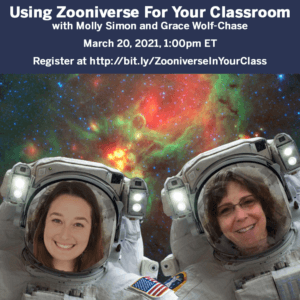 My Zooniverse presentations in 2021 also included tutorials for educators working with diverse student populations. In March 2021 I conducted a Skype-a-Scientist session with Molly Simon, an Arizona State University professor who utilizes citizen science as a tool to bring authentic research experiences to students in both in-person and online courses. I also participated in online workshops organized by the American Association of Physical (now “Biological”) Anthropologists and the Society of Vertebrate Paleontology, which were designed to give educators resources for teaching biology and evolution in culturally sensitive ways.
My Zooniverse presentations in 2021 also included tutorials for educators working with diverse student populations. In March 2021 I conducted a Skype-a-Scientist session with Molly Simon, an Arizona State University professor who utilizes citizen science as a tool to bring authentic research experiences to students in both in-person and online courses. I also participated in online workshops organized by the American Association of Physical (now “Biological”) Anthropologists and the Society of Vertebrate Paleontology, which were designed to give educators resources for teaching biology and evolution in culturally sensitive ways.
Zooniverse is not a replacement for in-person community service programs. However, for individuals who are house-bound or simply want to use their “screen time” to engage in meaningful activities, it is a great alternative or supplement. In fact, many organizations encourage Zooniverse participation as a way to fulfill service hour requirements for graduation, scholarships, etc.4 Moreover, many of today’s youth interact daily through extended online communities of individuals with whom they share common interests. Such communities could function as wonderful hubs to connect young people with citizen science!
Zooniverse with Youth and Families
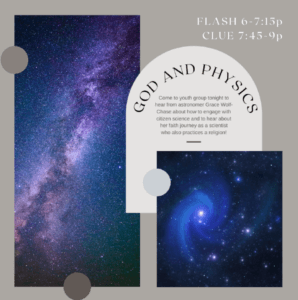
Flyer for an event with the Sunnyvale Youth Group
In addition to worship services, most faith communities have educational programs for youth, family, and adults. Rev. Harold Vanicek of St. Peter’s Lutheran Church in Marble Falls, Texas, used Zooniverse’s Penguin Watch project to give his confirmation class an experience with science while addressing students’ questions about faith and science. Penguin Watch entails helping scientists to identify and count adult penguins, chicks, and eggs in images from locations in Australia, New Zealand, and Antarctica. This is a great project that can be used at various educational levels from early elementary school on to teach about subjects like climate change and ecology. Because seabirds spend the majority of their life at sea and feed near the top of the food chain, changes in their populations are likely to reflect the changes occurring in the wider ecosystem, making them excellent indicators of the health of the marine environment, which in turn affects human populations. Seabirds are declining worldwide; under threat from climate change, pollution, disturbance and competition with fisheries. Penguin Watch is about collecting data on a large enough scale to understand these threats and, where possible, reverse them through policy changes.
Some Zooniverse projects are great for helping young people connect contemporary views of the Universe to ways of thinking about God. In February 2021, I co-led remote sessions themed around “God and Physics” for middle- and high-school students with youth leader Addie Domske at Sunnyvale Presbyterian Church in Sunnyvale, California. I introduced students to Zooniverse and led them through how to classify different types of galaxies in Galaxy Zoo, highlighting the potential for students to discover new things in images of distant galaxies, which help us to understand the scale of the Universe and how it has changed through time. Domske encouraged students to reflect on how the vastness of the Universe in time and space might expand and deepen the way they thought about God.
Zooniverse also provides a great platform for families to learn together. Hood Theological Seminary’s International Center of Faith, Science, and History (ICFSH), in partnership with the community organization Families and Communities Together (F.A.C.T.), hosts an annual intergenerational summer camp. I’m honored to have taken part in this camp the past couple of years, as it’s been conducted remotely. The camp has offered a great venue for showcasing Zooniverse activities related to camp science themes. In 2020, I was pleased to share my own research, which was made possible through a discovery by citizen scientists working on the Milky Way Project, a research project that’s helping us learn how stars form in our Galaxy. In 2021, the camp was devoted to ecology and the climate. I was happy to demonstrate how the Zooniverse project Fossil Atmospheres engages everyone in helping to track how Earth’s atmosphere has changed through time.
These are just a few examples that I hope may give readers some ideas for how Zooniverse might be integrated into their own programs!
Engaged Audiences
The Engaging initiative was evaluated through online surveys that were completed by individuals before and after participating in Zooniverse, a focus group I conducted during the summer of 2021, and many conversations that I held with prospective participants throughout the initiative. The information collected was designed to assess views on science and scientists; interest among faith leaders and communities in participating in citizen science; gather information on the types of projects and messaging that would appeal to different audiences and motivate continuing engagement; and obtain feedback regarding what did and didn’t work in integrating Zooniverse into programs of religious organizations. The entire Evaluation Report is available on the Center for Advancement of Informal Science Education (CAISE) informalscience.org website, which maintains a collection of project, research, and evaluation resources designed to support the informal STEM education community in a variety of learning environments.
Although the rate of survey return was low, the returned surveys paint a general picture of those who chose to respond. Survey respondents were diverse in religious affiliation; however, the majority tended to be highly-educated (though not necessarily in science), White, older adults who have mostly favorable views of science and scientists, and roughly 90% of respondents saw no conflict between science and their religious views. Even so, individual responses to open-ended questions revealed diverse reasons for these views and why respondents would or wouldn’t be likely to participate in citizen science. Respondents who actually knew scientists were likely to express confidence in scientists in general. Many respondents felt that scientists are subject to the same selfish motivations as everyone else; some felt that scientists employed in independent or academic research were less likely to be influenced by self-serving motives than scientists employed by corporations or industries that might be driven by economic, rather than humanitarian, interests. Most respondents either viewed science and religion as complementary or synergistic, indicating that science can often inform, challenge, deepen, or modify religious understandings. Lack of time was given more often than lack of interest as the predominant leading factor by those disinclined to participate in citizen science.
One major take away for me was that moving forward, we (meaning scientists and educators, whatever our own backgrounds) need to do better with engaging more ethnically diverse populations, and in building relationships with individuals and communities that may be more apprehensive about science! Minority populations, in particular, often have good reasons to distrust scientists. For example, minoritized and marginalized people have often been used, without their consent, in unethical medical experiments (e.g., Scharff et al. 2010). Poor and marginalized communities face disproportionate negative impacts of industrial pollution of the air, water and soil. Racism and discrimination continue to be prevalent in science culture and practice, and the level of trust is affected by the representation of one’s own culture within a given community (e.g., Odekunle 2020; Thorp 2020). Furthermore, research through the Religion and Public Life Program at Rice University indicates scientists need to talk about religion to address racial and gender disparities in science. Minority scientists who belong to religious communities, in particular, have a critical role to play in building bridges of trust to support ethnic and religious diversity and inclusion in science.5 By engaging with religious communities, scientists can play an important role in diversifying science itself, and ensuring that science and its applications are responsive to the concerns and priorities of all people. DoSER has recently released a series of videos to help scientists engage more effectively with religious communities. Respectful two-way communication between scientists and religious audiences, and active listening to the concerns of others, are critical in building trust between people who’ve traveled different paths in life.
Expanding the Zooniverse
A common theme that emerged during the Engaging initiative is the importance of ongoing partnerships between scientists and religious communities in order to build trust, understanding, and synergies that integrate scientific content with theological or ethical concerns. How can such partnerships be formed and maintained? Religious leaders themselves could identify scientists within their congregations who would be willing to lead parishioners in science projects. Indeed, in my experience, scientists in congregations want to help in ways that utilize their training and expertise. This shouldn’t be surprising, as faith communities often recruit parishioners who are building engineers to help maintain their places of worship, or individuals with experience organizing events to set up social functions such as pot-luck dinners. Why not recruit scientists to help address perceived conflicts between science and faith, or to lead projects that require scientific expertise?
There are both professional and informal networks that could help connect scientists with religious communities: DoSER, the American Scientific Affiliation, and the Clergy Letter Project (CLP), to name just a few. The last is an initiative to demonstrate the compatibility of science and religion, which includes signatories from numerous religious traditions. The CLP maintains a contact list of diverse religious leaders as well as Scientific Consultants that sign on to help clergy with scientific issues. Zooniverse leadership could also help identify members of research teams that are willing to help communities understand the content of their projects. Similarly, there are many publications of faith-based and interfaith organizations that could help recruit communities that are interested in integrating scientific experiences into their programs.
Through Engaging, I was able to work with many individual communities that are themselves members of larger organizations or networks. These networks could assist in the formation of “Affinity Groups”, where people from different backgrounds could participate in citizen-science projects that reflect their common interests. One such group might be formed through a coordinated effort that would recruit participants from the numerous interfaith organizations that are concerned with environmental justice to participate in a Zooniverse challenge, where participants could pledge to achieve a goal of a certain number of classifications on a project(s) of common interest. This could be advertised through Interfaith Power & Light (IPL), which connects affiliated organizations around the United States. IPL’s mission is to inspire and mobilize people of faith and conscience to take bold and just action on climate change. Affinity Groups might also be identified through the Interfaith Youth Core, a national nonprofit organization that is dedicated to building interfaith leaders on college campuses. Working together on projects is a powerful way to build bridges across differences.
To the best of my knowledge, the religious communities that are currently using Zooniverse in long-term or continuing programs as a result of the Engaging initiative had prior interest in bringing science into their programs, and/or had established programs into which Zooniverse projects could be easily integrated. Like everyone else, faith communities have struggled to maintain themselves and their programs during the pandemic, and this has certainly affected their ability to consider implementing new programs. Given the rifts in society, and in the interest of equity and inclusion, however, there is an urgent need to extend engagement beyond the “science-attentive” public to the “science-apprehensive” public, as well as to populations that are under-represented in science.
I believe that organizations such as the American Scientific Affiliation (ASA), BioLogos, the Emerging Scholars Network (a network within InterVarsity’s Graduate and Faculty Ministry), as well as Christian homeschool networks, have a crucial role to play in helping to engage evangelical Christian communities in citizen science. In the future, I hope to provide Zooniverse training workshops for ASA chapter members who would in turn connect with local leaders of evangelical congregations to discuss programming possibilities. Efforts to attract and engage under-represented populations should be done in concert with religious leaders that serve these populations, and through partnering with Historically Black Colleges and Universities (HBCUs) and other minority-serving institutions.
A Final Note
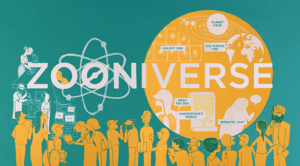 An increasing number of educators are providing students at all levels with opportunities to participate in real research, a practice that can benefit students and teachers alike. Course-based Undergraduate Research Experiences (CUREs) offer students hands-on experience doing original research, and offer faculty the opportunity to generate new information within their discipline (Auchincloss et al. 2017). CUREs focus on scientific practices like data collection, analysis, and formulating follow-up questions. Unlike typical laboratory exercises, they involve the discovery of unknown outcomes. Unlike internships, which are accessible only to a few exceptional students, CUREs enable an entire classroom to engage with research of genuine interest to the academic community. A growing body of research shows that CUREs, particularly at the introductory course level, increase student cognitive gains and interest in science, and may be a way to improve the diversity of the scientific community (Bangera & Brownell 2014; Dolan 2014 and references therein; Auchincloss et al. 2017).
An increasing number of educators are providing students at all levels with opportunities to participate in real research, a practice that can benefit students and teachers alike. Course-based Undergraduate Research Experiences (CUREs) offer students hands-on experience doing original research, and offer faculty the opportunity to generate new information within their discipline (Auchincloss et al. 2017). CUREs focus on scientific practices like data collection, analysis, and formulating follow-up questions. Unlike typical laboratory exercises, they involve the discovery of unknown outcomes. Unlike internships, which are accessible only to a few exceptional students, CUREs enable an entire classroom to engage with research of genuine interest to the academic community. A growing body of research shows that CUREs, particularly at the introductory course level, increase student cognitive gains and interest in science, and may be a way to improve the diversity of the scientific community (Bangera & Brownell 2014; Dolan 2014 and references therein; Auchincloss et al. 2017).
As part of a small NASA grant, my research colleagues and I are currently beta-testing and evaluating a CURE we developed for introductory astronomy classes based on a discovery made by citizen scientists who worked on the Milky Way Project. We intend to distribute our CURE widely, training instructors on how it can be integrated into their classes, and focusing specifically on institutions that serve under-represented students. Participating students will learn important concepts in astronomy, and at the same time, contribute to our understanding of how stars form and develop.
Beyond the classroom, citizen science offers a great opportunity to build bridges of understanding and partnerships between diverse communities. On average Americans spend less than 5% of their lives in classrooms, and a growing body of evidence demonstrates that most science is learned outside of school, in informal environments (Falk & Dierking 2010). In general, people acquire their views about science from many different sources — some reliable and some not. Participating in citizen science is a powerful way to learn from, and along with, the individuals who do science professionally.
If you’d like further information, please check out our Engaging Faith-based Communities in Citizen Science through Zooniverse website, and contact me through that website if you’d like to explore ideas for engaging your community!
References
Auchincloss, L. C., Laursen, S. L., Branchaw, J. L., Eagan, K., Graham, M., Hanauer, D. I., Lawrie, G., McLinn, C. M., Pelaez, N., Rowland, S., Towns, M., Trautmann, N. M., Varma-Nelson, P., Weston, T. J., & Dolan, E. L. 2017, Assessment of Course-Based Undergraduate Research Experiences: A Meeting Report, CBE Life Sci. Educ., 13, 29-40
Bangera, G. & Brownell, S. E. 2014, Course-Based Undergraduate Research Experiences Can Make Scientific Research More Inclusive, CBE Life Sci. Educ., 13, 602-606
Barnes, M. E. & Brownell, S. E. 2018, A Call to Use Cultural Competence When Teaching Evolution to Religious College Students: Introducing Religious Cultural Competence in Evolution Education (ReCCEE), CBE Life Sci. Educ., 16:es4, (10 pp.)
Bolger, D. & Ecklund, E. H. 2020, Seeing is Achieving: Religion, Embodiment, and Explanations of Racial Inequality in STEM, Ethnic and Racial Studies, DOI: 10.1080/01419870.2020.1791354
Dolan, E. L. 2014, https://sites.nationalacademies.org/cs/groups/dbassesite/documents/webpage/dbasse_177288.pdf, last accessed October 28, 2021
Ecklund, E. H., Johnson, D. R., Vaidyanathan, B., Matthews, K. R. W., Lewis, S. W., Thomson., R. A. Jr., & Di, D. 2019, Secularity and Science: What Scientists Around the World Really Think About Religion (New York, NY: Oxford University Press, 203-204)
Falk, J. H. & Dierking, L. D. 2010, The 95 Percent Solution, American Scientist, 98, 486-493
Odekunle, E. A. 2020, Dismantling systemic racism in science, Science, 369 (6505), 780-781
Scharff, D. P., Mathews, K. J., Jackson, P., Hoffsuemmer, J., Martin, E. & Edwards, D. 2010, More than Tuskegee: understanding mistrust about research participation, Journal of Health Care for the Poor and Underserved, 21 (3), 879–897.
Thorp, H. H. 2020, Time to look in the mirror, Science, 368 (6496), 1161
———————————————————————
The initiative described in this article was based upon work supported by the Alfred P. Sloan Foundation. Any opinions, findings, or recommendations expressed are those of the authors and do not necessarily reflect the views of the Sloan Foundation.





